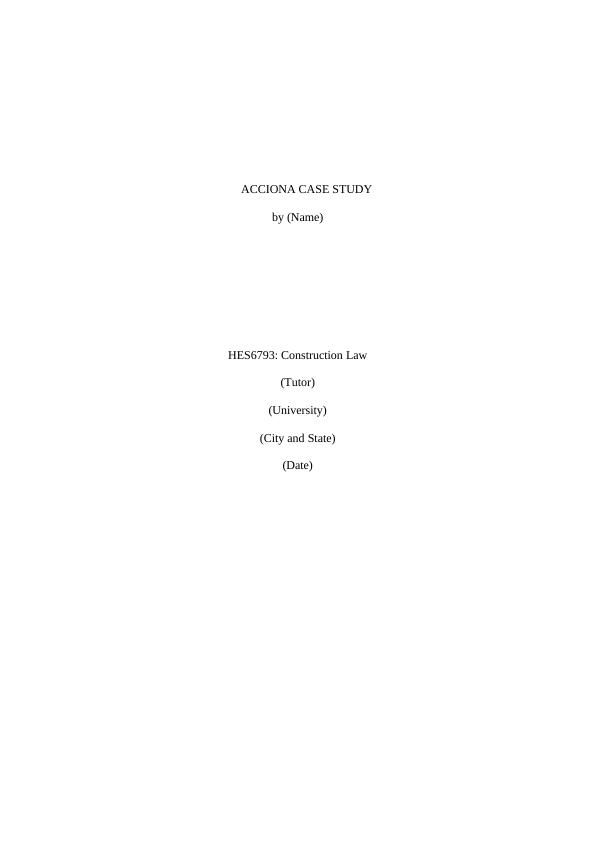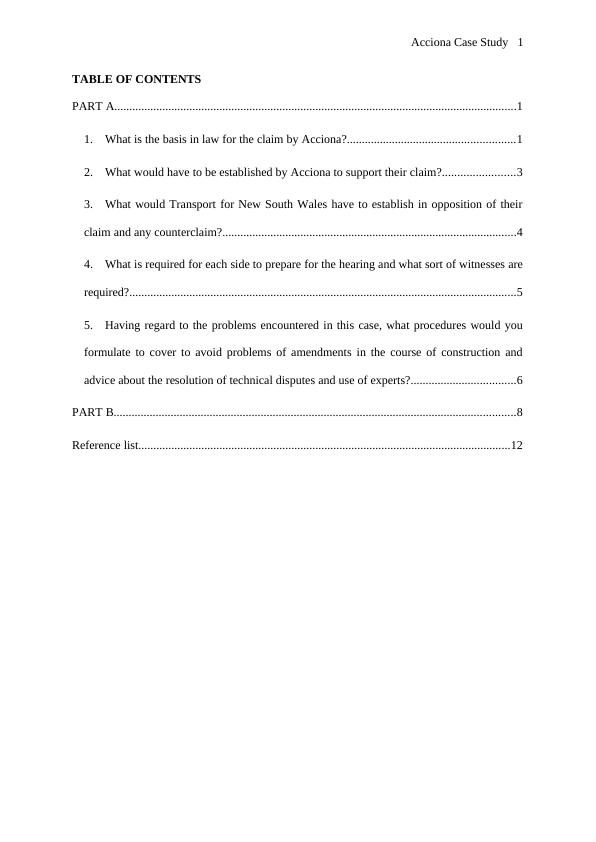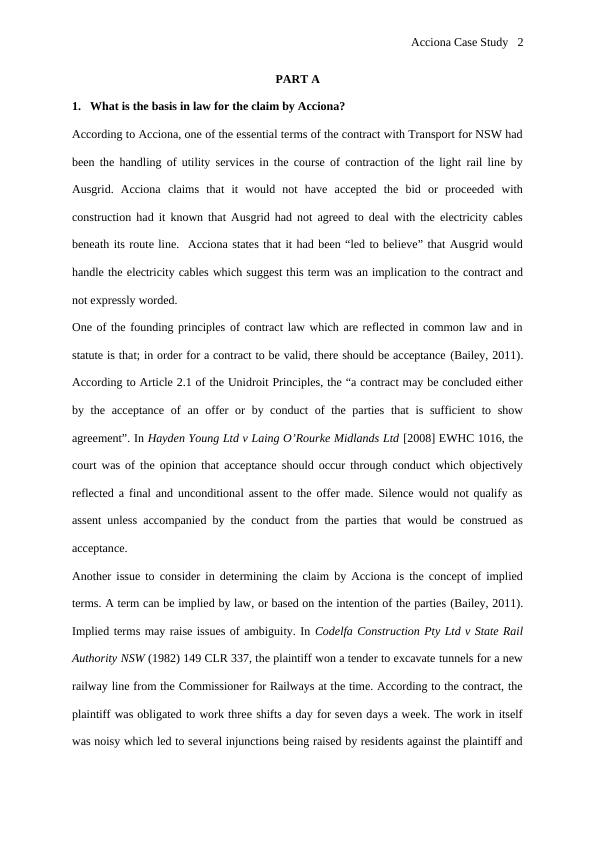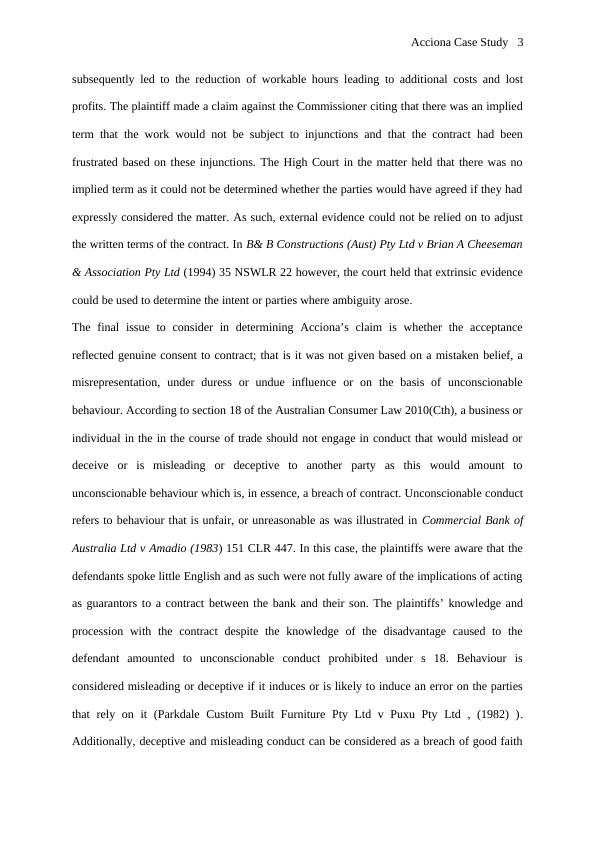HES6793 Construction Law - Doc
15 Pages4374 Words26 Views
Added on 2021-05-31
HES6793 Construction Law - Doc
Added on 2021-05-31
ShareRelated Documents
ACCIONA CASE STUDY
by (Name)
HES6793: Construction Law
(Tutor)
(University)
(City and State)
(Date)
by (Name)
HES6793: Construction Law
(Tutor)
(University)
(City and State)
(Date)

Acciona Case Study 1
TABLE OF CONTENTS
PART A......................................................................................................................................1
1. What is the basis in law for the claim by Acciona?........................................................1
2. What would have to be established by Acciona to support their claim?........................3
3. What would Transport for New South Wales have to establish in opposition of their
claim and any counterclaim?..................................................................................................4
4. What is required for each side to prepare for the hearing and what sort of witnesses are
required?.................................................................................................................................5
5. Having regard to the problems encountered in this case, what procedures would you
formulate to cover to avoid problems of amendments in the course of construction and
advice about the resolution of technical disputes and use of experts?...................................6
PART B......................................................................................................................................8
Reference list............................................................................................................................12
TABLE OF CONTENTS
PART A......................................................................................................................................1
1. What is the basis in law for the claim by Acciona?........................................................1
2. What would have to be established by Acciona to support their claim?........................3
3. What would Transport for New South Wales have to establish in opposition of their
claim and any counterclaim?..................................................................................................4
4. What is required for each side to prepare for the hearing and what sort of witnesses are
required?.................................................................................................................................5
5. Having regard to the problems encountered in this case, what procedures would you
formulate to cover to avoid problems of amendments in the course of construction and
advice about the resolution of technical disputes and use of experts?...................................6
PART B......................................................................................................................................8
Reference list............................................................................................................................12

Acciona Case Study 2
PART A
1. What is the basis in law for the claim by Acciona?
According to Acciona, one of the essential terms of the contract with Transport for NSW had
been the handling of utility services in the course of contraction of the light rail line by
Ausgrid. Acciona claims that it would not have accepted the bid or proceeded with
construction had it known that Ausgrid had not agreed to deal with the electricity cables
beneath its route line. Acciona states that it had been “led to believe” that Ausgrid would
handle the electricity cables which suggest this term was an implication to the contract and
not expressly worded.
One of the founding principles of contract law which are reflected in common law and in
statute is that; in order for a contract to be valid, there should be acceptance (Bailey, 2011).
According to Article 2.1 of the Unidroit Principles, the “a contract may be concluded either
by the acceptance of an offer or by conduct of the parties that is sufficient to show
agreement”. In Hayden Young Ltd v Laing O’Rourke Midlands Ltd [2008] EWHC 1016, the
court was of the opinion that acceptance should occur through conduct which objectively
reflected a final and unconditional assent to the offer made. Silence would not qualify as
assent unless accompanied by the conduct from the parties that would be construed as
acceptance.
Another issue to consider in determining the claim by Acciona is the concept of implied
terms. A term can be implied by law, or based on the intention of the parties (Bailey, 2011).
Implied terms may raise issues of ambiguity. In Codelfa Construction Pty Ltd v State Rail
Authority NSW (1982) 149 CLR 337, the plaintiff won a tender to excavate tunnels for a new
railway line from the Commissioner for Railways at the time. According to the contract, the
plaintiff was obligated to work three shifts a day for seven days a week. The work in itself
was noisy which led to several injunctions being raised by residents against the plaintiff and
PART A
1. What is the basis in law for the claim by Acciona?
According to Acciona, one of the essential terms of the contract with Transport for NSW had
been the handling of utility services in the course of contraction of the light rail line by
Ausgrid. Acciona claims that it would not have accepted the bid or proceeded with
construction had it known that Ausgrid had not agreed to deal with the electricity cables
beneath its route line. Acciona states that it had been “led to believe” that Ausgrid would
handle the electricity cables which suggest this term was an implication to the contract and
not expressly worded.
One of the founding principles of contract law which are reflected in common law and in
statute is that; in order for a contract to be valid, there should be acceptance (Bailey, 2011).
According to Article 2.1 of the Unidroit Principles, the “a contract may be concluded either
by the acceptance of an offer or by conduct of the parties that is sufficient to show
agreement”. In Hayden Young Ltd v Laing O’Rourke Midlands Ltd [2008] EWHC 1016, the
court was of the opinion that acceptance should occur through conduct which objectively
reflected a final and unconditional assent to the offer made. Silence would not qualify as
assent unless accompanied by the conduct from the parties that would be construed as
acceptance.
Another issue to consider in determining the claim by Acciona is the concept of implied
terms. A term can be implied by law, or based on the intention of the parties (Bailey, 2011).
Implied terms may raise issues of ambiguity. In Codelfa Construction Pty Ltd v State Rail
Authority NSW (1982) 149 CLR 337, the plaintiff won a tender to excavate tunnels for a new
railway line from the Commissioner for Railways at the time. According to the contract, the
plaintiff was obligated to work three shifts a day for seven days a week. The work in itself
was noisy which led to several injunctions being raised by residents against the plaintiff and

Acciona Case Study 3
subsequently led to the reduction of workable hours leading to additional costs and lost
profits. The plaintiff made a claim against the Commissioner citing that there was an implied
term that the work would not be subject to injunctions and that the contract had been
frustrated based on these injunctions. The High Court in the matter held that there was no
implied term as it could not be determined whether the parties would have agreed if they had
expressly considered the matter. As such, external evidence could not be relied on to adjust
the written terms of the contract. In B& B Constructions (Aust) Pty Ltd v Brian A Cheeseman
& Association Pty Ltd (1994) 35 NSWLR 22 however, the court held that extrinsic evidence
could be used to determine the intent or parties where ambiguity arose.
The final issue to consider in determining Acciona’s claim is whether the acceptance
reflected genuine consent to contract; that is it was not given based on a mistaken belief, a
misrepresentation, under duress or undue influence or on the basis of unconscionable
behaviour. According to section 18 of the Australian Consumer Law 2010(Cth), a business or
individual in the in the course of trade should not engage in conduct that would mislead or
deceive or is misleading or deceptive to another party as this would amount to
unconscionable behaviour which is, in essence, a breach of contract. Unconscionable conduct
refers to behaviour that is unfair, or unreasonable as was illustrated in Commercial Bank of
Australia Ltd v Amadio (1983) 151 CLR 447. In this case, the plaintiffs were aware that the
defendants spoke little English and as such were not fully aware of the implications of acting
as guarantors to a contract between the bank and their son. The plaintiffs’ knowledge and
procession with the contract despite the knowledge of the disadvantage caused to the
defendant amounted to unconscionable conduct prohibited under s 18. Behaviour is
considered misleading or deceptive if it induces or is likely to induce an error on the parties
that rely on it (Parkdale Custom Built Furniture Pty Ltd v Puxu Pty Ltd , (1982) ).
Additionally, deceptive and misleading conduct can be considered as a breach of good faith
subsequently led to the reduction of workable hours leading to additional costs and lost
profits. The plaintiff made a claim against the Commissioner citing that there was an implied
term that the work would not be subject to injunctions and that the contract had been
frustrated based on these injunctions. The High Court in the matter held that there was no
implied term as it could not be determined whether the parties would have agreed if they had
expressly considered the matter. As such, external evidence could not be relied on to adjust
the written terms of the contract. In B& B Constructions (Aust) Pty Ltd v Brian A Cheeseman
& Association Pty Ltd (1994) 35 NSWLR 22 however, the court held that extrinsic evidence
could be used to determine the intent or parties where ambiguity arose.
The final issue to consider in determining Acciona’s claim is whether the acceptance
reflected genuine consent to contract; that is it was not given based on a mistaken belief, a
misrepresentation, under duress or undue influence or on the basis of unconscionable
behaviour. According to section 18 of the Australian Consumer Law 2010(Cth), a business or
individual in the in the course of trade should not engage in conduct that would mislead or
deceive or is misleading or deceptive to another party as this would amount to
unconscionable behaviour which is, in essence, a breach of contract. Unconscionable conduct
refers to behaviour that is unfair, or unreasonable as was illustrated in Commercial Bank of
Australia Ltd v Amadio (1983) 151 CLR 447. In this case, the plaintiffs were aware that the
defendants spoke little English and as such were not fully aware of the implications of acting
as guarantors to a contract between the bank and their son. The plaintiffs’ knowledge and
procession with the contract despite the knowledge of the disadvantage caused to the
defendant amounted to unconscionable conduct prohibited under s 18. Behaviour is
considered misleading or deceptive if it induces or is likely to induce an error on the parties
that rely on it (Parkdale Custom Built Furniture Pty Ltd v Puxu Pty Ltd , (1982) ).
Additionally, deceptive and misleading conduct can be considered as a breach of good faith

End of preview
Want to access all the pages? Upload your documents or become a member.
Related Documents
(Solved) Assignment on Construction Lawlg...
|12
|3567
|31
(Solution) Assignment on Construction Lawlg...
|14
|4122
|72
Unidroit Principles in Construction Law Name of the Student Namelg...
|14
|4388
|455
CLR 337 Assignment on Australian Commercial Lawlg...
|4
|1238
|99
Construction and Property Law - PDFlg...
|13
|2465
|67
LAW OF COMMERCE.lg...
|4
|631
|48
